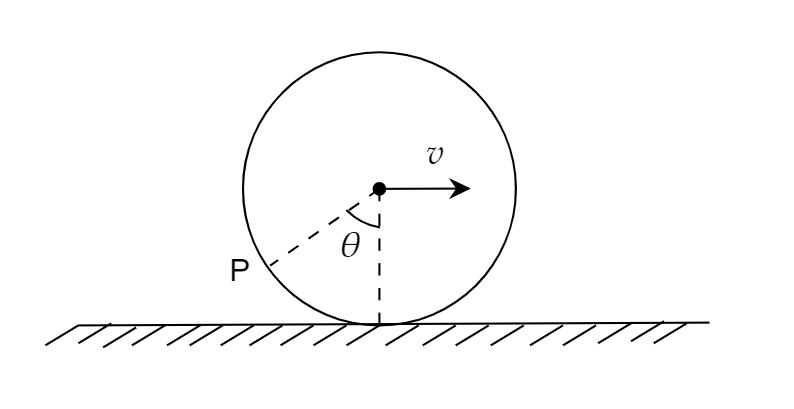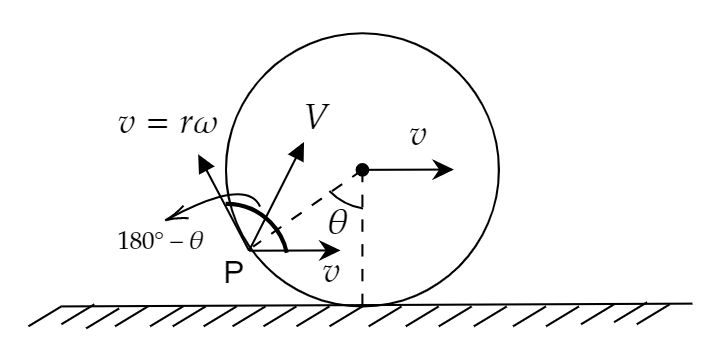
A hoop rolls on a horizontal ground without slipping with linear speed $ v $ . Speed of a particle P on the circumference of the hoop at an angle $ \theta $ is:

A. $ 2v\sin \left( {\dfrac{\theta }{2}} \right) $
B. $ v\sin \theta $
C. $ 2v\cos \left( {\dfrac{\theta }{2}} \right) $
D. $ v\cos \theta $

Answer
379.8k+ views
Hint: In the given question, the particle is in rolling motion. At point P it will have both angular velocity and linear velocity, we have to find the resultant velocity from that point. By formulating and comparing equations we will find the answer.
Complete step by step solution:
According to the question, the hoop is in rolling motion on the horizontal ground without slipping. So, at point P the hoop is moving with both linear velocity $ v $ and angular velocity $ v $ .
The direction of the angular velocity is tangential to the point at which it acts.

Let the speed of the particle be $ V $ and the angle between the angular velocity and linear velocity is $ {180^ \circ } - \theta $ .
From parallelogram law of vector, we get the speed of the particle as,
$ V = \sqrt {{v^2} + {v^2} + 2.v.v\cos \left( {{{180}^ \circ } - \theta } \right)} $
Simplifying the given equation we get,
$ V = \sqrt {2{v^2} - 2{v^2}\cos \theta } $
Now, taking $ 2{v^2} $ as common we get,
$ V = \sqrt {2{v^2}\left( {1 - \cos \theta } \right)} $
Now, taking $ 2{v^2} $ out of the square root, we get,
$ V = \sqrt 2 v\sqrt {\left( {1 - \cos \theta } \right)} $
From Trigonometric half angle formula, we know that $ 1 - \cos \theta = 2{\sin ^2}\dfrac{\theta }{2} $
Substituting its value we get,
$ V = \sqrt 2 v\sqrt {2{{\sin }^2}\dfrac{\theta }{2}} $
Hence, $ V = 2v\sin \dfrac{\theta }{2} $
The correct option is A. $ 2v\sin \left( {\dfrac{\theta }{2}} \right) $ .
Note:
It must be noted that as the surface is frictionless, so the angular velocity at point P and linear velocity are equal. If the surface had friction, then the angular velocity and linear velocity will not be the same. The angle between the two vectors is found from the parallelogram as we extend the velocity direction.
Complete step by step solution:
According to the question, the hoop is in rolling motion on the horizontal ground without slipping. So, at point P the hoop is moving with both linear velocity $ v $ and angular velocity $ v $ .
The direction of the angular velocity is tangential to the point at which it acts.

Let the speed of the particle be $ V $ and the angle between the angular velocity and linear velocity is $ {180^ \circ } - \theta $ .
From parallelogram law of vector, we get the speed of the particle as,
$ V = \sqrt {{v^2} + {v^2} + 2.v.v\cos \left( {{{180}^ \circ } - \theta } \right)} $
Simplifying the given equation we get,
$ V = \sqrt {2{v^2} - 2{v^2}\cos \theta } $
Now, taking $ 2{v^2} $ as common we get,
$ V = \sqrt {2{v^2}\left( {1 - \cos \theta } \right)} $
Now, taking $ 2{v^2} $ out of the square root, we get,
$ V = \sqrt 2 v\sqrt {\left( {1 - \cos \theta } \right)} $
From Trigonometric half angle formula, we know that $ 1 - \cos \theta = 2{\sin ^2}\dfrac{\theta }{2} $
Substituting its value we get,
$ V = \sqrt 2 v\sqrt {2{{\sin }^2}\dfrac{\theta }{2}} $
Hence, $ V = 2v\sin \dfrac{\theta }{2} $
The correct option is A. $ 2v\sin \left( {\dfrac{\theta }{2}} \right) $ .
Note:
It must be noted that as the surface is frictionless, so the angular velocity at point P and linear velocity are equal. If the surface had friction, then the angular velocity and linear velocity will not be the same. The angle between the two vectors is found from the parallelogram as we extend the velocity direction.
Recently Updated Pages
The correct geometry and hybridization for XeF4 are class 11 chemistry CBSE

Water softening by Clarks process uses ACalcium bicarbonate class 11 chemistry CBSE

With reference to graphite and diamond which of the class 11 chemistry CBSE

A certain household has consumed 250 units of energy class 11 physics CBSE

The lightest metal known is A beryllium B lithium C class 11 chemistry CBSE

What is the formula mass of the iodine molecule class 11 chemistry CBSE

Trending doubts
The reservoir of dam is called Govind Sagar A Jayakwadi class 11 social science CBSE

What problem did Carter face when he reached the mummy class 11 english CBSE

Proton was discovered by A Thomson B Rutherford C Chadwick class 11 chemistry CBSE

In China rose the flowers are A Zygomorphic epigynous class 11 biology CBSE

What is Environment class 11 chemistry CBSE

Nucleolus is present in which part of the cell class 11 biology CBSE




